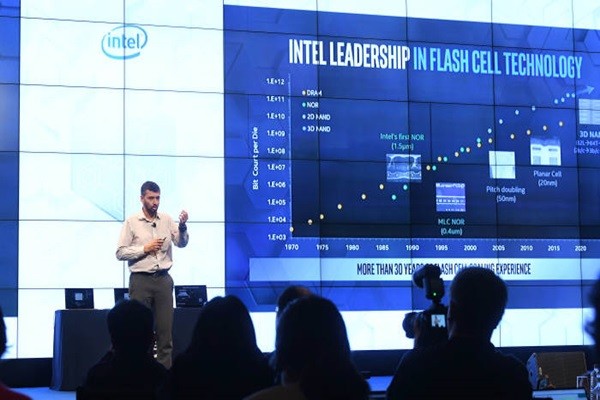Intel is set to release world’s first SSD (Solid State Drive) with 144-layer NAND flash memory next year. Intel held an event in South Korea that is the leader of world’s memory semiconductor markets and announced its plan to advance towards memory market. Its plan is to chase after top businesses within memory market through its Optane technology alone with 144-layer NAND flash memory.
Intel held ‘Memory & Storage Day 2019’ at JW Marriott Hotel on the 26th and introduced some of its memory semiconductor products.
Fact that Intel held an event in South Korea, where Samsung Electronics and SK Hynix that are two powerhouses within memory semiconductor market, is significant as it indicates that it will be aggressively go after memory market on top of CPU market that is Intel’s main business.
Intel introduced 144-layer QLC (Quad Level Cell) NAND flash memory as one of its weapons to target NAND flash memory market where 70% of its shares are owned by Samsung Electronics and SK Hynix.
NAND flash memory stores information for an IT device and it is made by stacking cells that store information layer upon layer. It requires advanced technology that can stack cells to a hairline and thinly.
QLC technology can store more information than TLC technology, which is currently the main technology that is widely used, as it has one more cell. Samsung Electronics and SK Hynix are currently the ones that can stack higher number of layers. Both businesses finished development of 128-layer NAND flash memory and are gearing up for mass-production.
Intel is planning to launch its 144-layer NAND flash memory next year and it is expected to compete fiercely with South Korean businesses. It is looking to go on the offensive within SSD market next year as it is confident with the yield.
“We know that the yield of 128-layer NAND flash memory of our competitors is not very high.” said Senior Vice President Rob Crooke of Intel. “We are confident that the yield of 144-layer NAND flash memory will not be an issue.”

Intel is also planning to launch 96-layer NAND flash memory during the fourth quarter of this year and is looking to quickly expand its lineup of NAND flash memories. It is also focusing on telling the public about its datacenter memory device called ‘Optane DC Persistence Memory’ that will be made to the public for the first time during the fourth quarter. Optane technology is based on Intel’s XPoint technology that Intel has been working on for about ten years.
This memory device combines strengths of DRAM and NAND flash memory. Intel explains that it has secured a technology that can change the dynamics of memory market through higher memory capacity than DRAM, non-volatile memory, and byte manipulation.
Intel concentrated all of its efforts into informing others about Optane technology by having a booth that compares information processing speed of its competitors’ DRAMs to its product. It also showed a video that shows production of Optane memories at its facility in New Mexico.
“Although there were rumors about changes to our investments in memory business and acquisition of our NAND flash memory business by SK Hynix, these upcoming new products will completely wipe out all the rumors.” said a representative for Intel.
Experts believe that Intel will force many South Korean businesses in relevant industries to be nervous.
“If Intel continues to launch new memory products and CPUs that are optimized for these memory products, it will be able to quickly chase after Samsung Electronics and SK Hynix in a short period of time.” said a representative for the industry.
Staff Reporter Kang, Hyeryung | kang@etnews.com